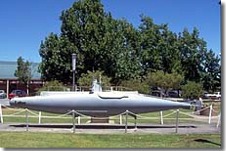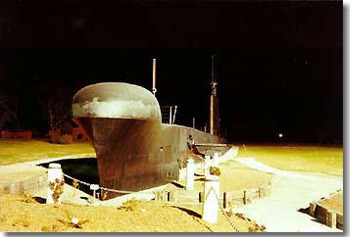|
Holbrook, New South Wales, Submarine Town
If you drive along the Hume Highway which links the major Australian cities of Melbourne and Sydney, you eventually arrive at the small country town of Holbrook. It is located 400 kilometers from the ocean, and about 500 kilometres from Sydney, my country’s largest city. Imagine your suprise, when you are suddenly confronted, in a park, in the main street of Holbrook, with the huge 90 metre long casing and fin of the RAN Submarine HMAS Otway, squatting in it’s concrete dock. How did it get there and why? It is quite a story. Early days. Johann Pabst, a shepherd, had arrived in Australia from Germany in 1825, and he went to work for the Australian Agricultural Company, which had been founded by John Macarthur. In 1838, Pabst, his wife and two daughters, arrived at Ten Mile Creek (now Holbrook), by 1858, the growing settlement there was known as Germantown, Pabst later took up the licence of a Grog Shop called the Woolpack Inn, which was located on the southern bank of Ten Mile Creek. World War 1.
He was awarded the Victoria Cross, the first one for the Navy in WW1. So, the suggestion that the name of Germantown should be replaced with the name of this new Naval hero, Holbrook, was endorsed with enthusiasm, and adopted by the Council on the 24th. of August 1915. Holbrook remains today the only town in Australia to be named after a VC winner. Norman Holbrook had been born at Southsea, Hampshire on the 9th. of July in 1888. The link of Holbrook to Submarines. Norman Holbrook went on to be promoted to Commander in the Royal Navy, and he visited his namesake on several occasions before his death at Midhurst in Sussex on the 9th. of July in 1976. In 1982, his widow Gundula Holbrook, donated her husband’s medals to the town. The link between Holbrook and Submarines was further cemented with the RAN’s Submarine Squadron over 1986-1992, when they were given Freedom of Entry to the Shire, but then this Squadron was reassigned to a base in Western Australia, and regular visits to Holbrook of necessity ceased.
The Oberon class Submarine HMAS Otway served in the RAN from 1968-1995. She had been named by Her Royal Highness Princess Marina at Scotts’ Yard, and launched on the 29th. of November in 1966, and commissioned into the Royal Australian Navy on the 24th. of April 1968. Otway was named after a cliffy promontory on the coastline of the State of Victoria, in turn, it had been named originally by Lieutenant James Grant, Commander of HMS Lady Nelson, in 1800, Cape Albany Otway, after a Royal Navy Captain of that name, who later went on to be promoted to Admiral. Over her 27 years of service, Otway steamed some 415,000 miles. After Otway decommissioned, the RAN presented her Casing and Fin to the town of Holbrook, but finance to cover its cutting into several parts, transport from Sydney to Holbrook, about 500 kilometres, and then her reconstruction presented the town Council with a real hurdle. Mrs. Gundula Holbrook to the rescue. Otway’s structure was cut into several sections, and together with the imposing Fin, was transported by semi trailer down the Hume Highway from Sydney to Holbrook. There it was reconstructed, and bedded down into a concrete dock, and on the Queen’s Birthday long weekend over 7/8th. of June in 1997, in the presence of it’s benefactor Gundula Holbrook, this Submarine Memorial was dedicated. A further challenge still to be met. Stop by at Holbrook. After visiting the Submarine Memorial, I can recommend that you visit the Bakery almost across the road from this park, where you may refuel and relax for a time, before taking to the road once more to continue your journey to wherever your final destination may be. Conclusion. |



